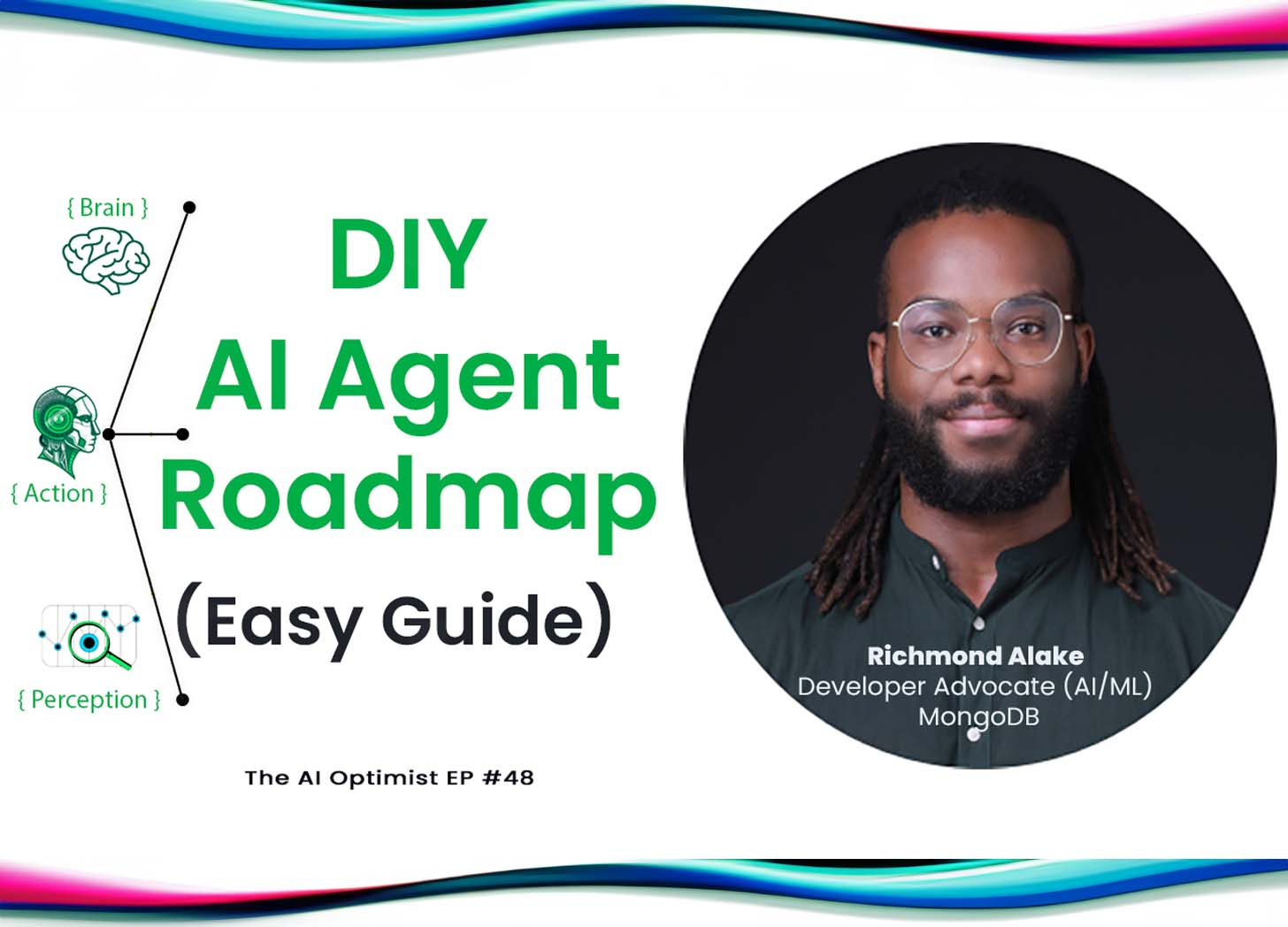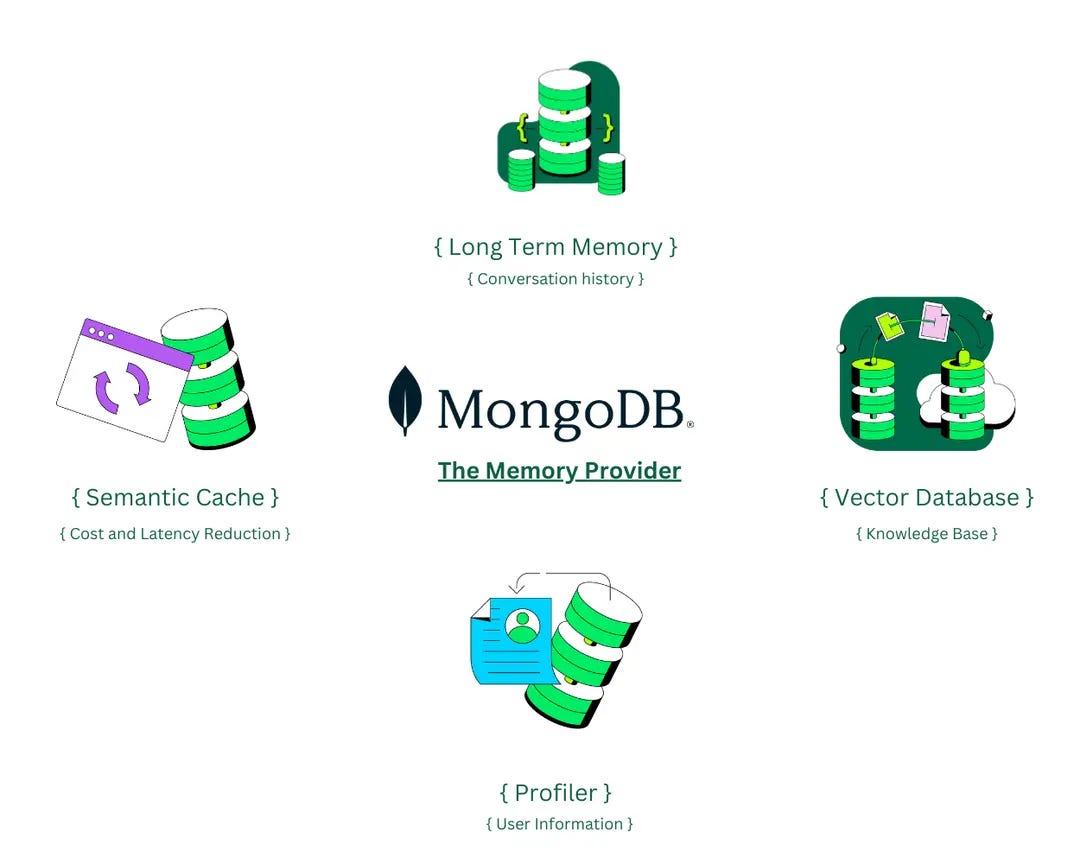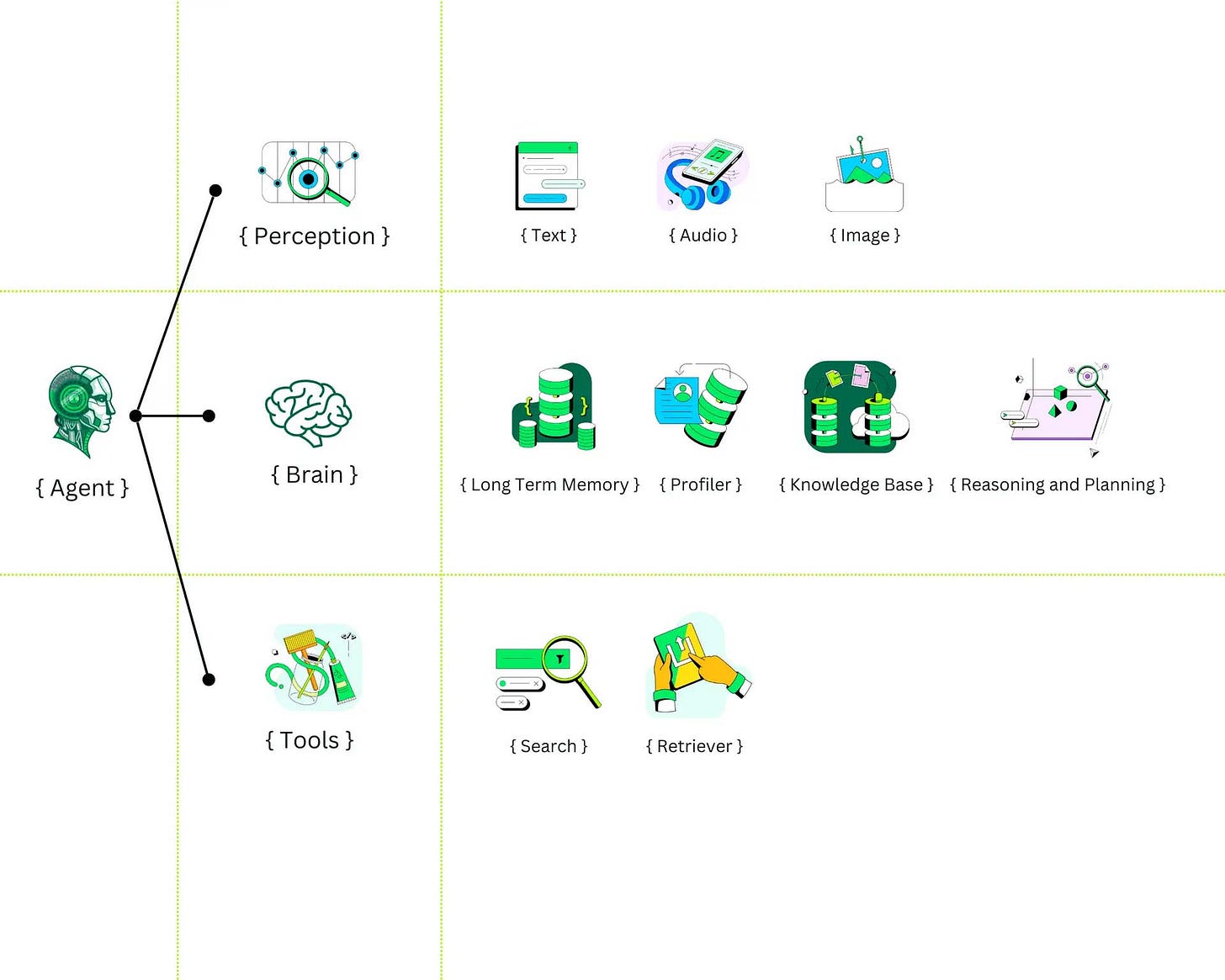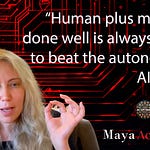"Start with the customer. What are they telling you in the agent space that they want or is missing?" Richmond Alake
In the early days of AI, Agents come with a bit of hype and a ton of promise, if you begin with simple steps.
This DIY AI Agent Roadmap walks you through the before, during, and after of creating 2 simple AI Agents.
And if you’d like a free test drive of MongoDB, Richmond shares this:
Richmond Alake, Developer Advocate at MongoDB for Startups, shows us how he’s creating AI agents—software that can sense, process information, make decisions, and take action, promising a new era of intelligent automation.
The key here is promise, we’re not close to what some are trying to do with the tools right now. Many push AI Agents to do too much, instead of starting simply.
Instead of swimming down rabbit holes of possibilities, Richmond begins with what’s in front of him at MongoDB, tasks costing him an hour or two a day.
By focusing on the small tasks, he develops future use cases based on experience and not another AI prediction of the future.
His entrepreneurial curiosity has led him to develop AI agents, along with his daily routine of creating technical content and engaging with customers.
He also shares videos, documents, and GitHub code for the AI Agents:
GENAI Build Repository (Github) - Code related to this podcast
https://github.com/mongodb-developer/GenAI-ShowcaseMongoDB For Startups, with a strong developer community.
His role revolves around enabling developers with knowledge and tools. It focuses on the processes and steps towards an emerging frontier: AI agents.
But how do you go about 'agentifying' existing processes?
Alake felt compelled to find out firsthand.
'Agentification' is the process of transforming manual tasks into automated actions performed by AI assistants, or 'agents '.
"The difficult part was not implementing the agent itself," he recounted.
"It was thinking through how to approach it - deconstructing the process into modular tools that an agent could execute."
Alake sets out to explore using AI Agents.
First stop? His backyard - the routines and workflows from his daily professional life.
He outlines his process for 'agentification' - transforming manual tasks into automated actions by AI assistants.
This involves deconstructing existing workflows to identify opportunities for automation, designing and implementing the AI agent's 'tools' or actions, and testing and refining the agent's performance.
"How do I break down the process into tools? Not everything needs to be agentified. Humans still need to remain in the loop."
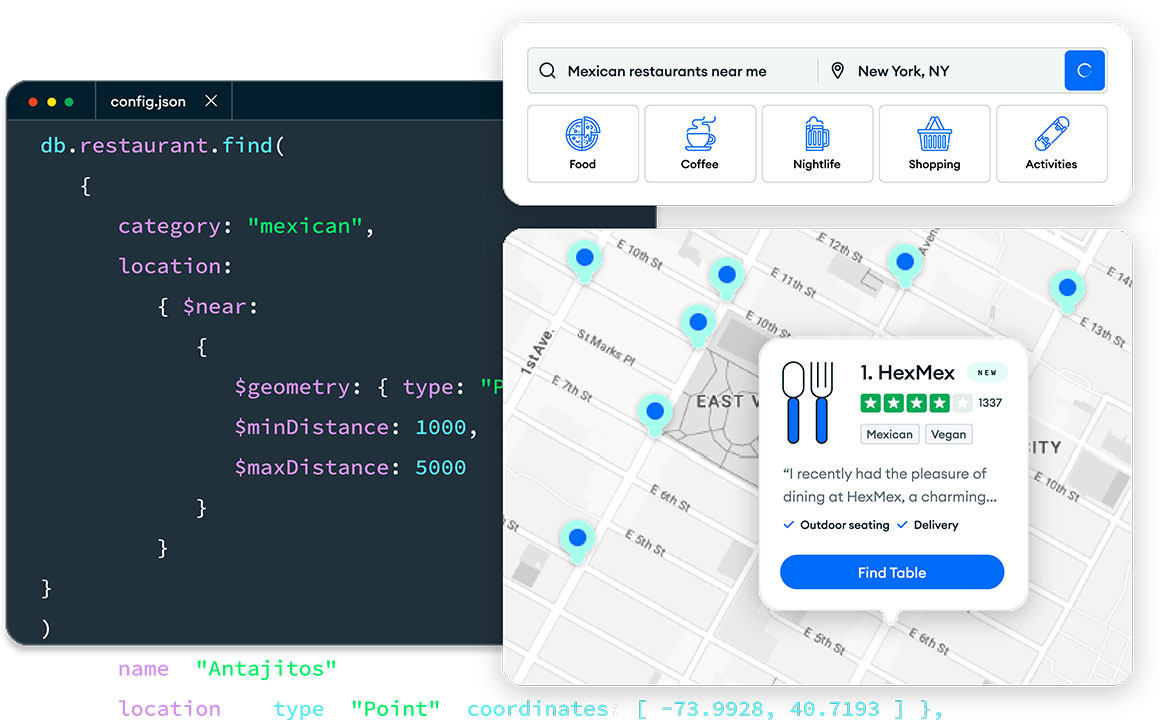
AI Agent Planning and Identifying Use Cases
Richmond shared a step-by-step approach to planning AI agents:
Identify Manual Processes: Lay out all manual processes and understand them thoroughly.
Break Down Processes into Tools: Turn each step into a tool the AI agent can use.
Automate Step-by-Step: Gradually automate each part of the process
Two Key Use Cases:
· Building an AI agent streamlining the technical review process for articles and documents, automating comment insertion and feedback.
· Developing an 'AI Researcher' agent to search archives, retrieve relevant research papers based on keywords, and select the most appropriate paper for a given use case. This AI agent could significantly speed up the research process, allowing researchers to focus more on analysis and interpretation rather than manual search and retrieval of papers.
1. The AI Agent: Technical Review Transformation
Alake's core responsibilities include reviewing technical articles and documentation from authors and peers. This involves a methodical process of editorial oversight, code examination, and inserting comments or change requests.
"I wanted to understand the agent space better," he explained. "But before trying to replace others, why don't I replace myself first?"
Alake mapped out the technical review workflow like a flowchart, scrutinizing each step for opportunities to "agentify" and transform into modular tools an AI assistant could wield.
Using LangChain and leveraging the memory capabilities of MongoDB, he constructs an agent to ingest a Google Docs link, parse the content, and automatically insert review comments.
MongoDB, a popular NoSQL database, plays a crucial role in storing and retrieving the memory of the AI agent.
"Within a few hours, I had replaced myself with an agent," Alake marveled. But this was just the first step.
2. The AI Agent Researcher Experiment
Alake's continued with document reviews. He recognizes another pain point ripe for optimization: researching academic papers and literature.
"I’m creating an agent that searches through archives using specific keywords and retrieves relevant research papers," he explains. "It's something I often find myself doing."
This "AI Researcher" agent demonstrates the potential of AI assistants. By storing conversation history in a MongoDB database, the agent could reference prior context and better align its actions, like recommending the relevant paper for a particular use case.
"You can start to see how this could enable all sorts of possibilities when you have an agent with access to research papers and memory of previous conversations," Alake enthusiastically describes.
The BAP Framework: Brain, Action, Perception
As Alake goes deeper into agentification, a framework starts to crystallize - a mental model he calls "BAP" to encapsulate the three core components underpinning an effective AI agent:
1. Brain: Providing long-term and short-term memory capabilities through vector databases like MongoDB and semantic caching, allowing the agent to "learn" from past experiences.
2. Action: Defining the specific "tools" or actions the agent could execute, such as authenticating access, reading documents, inserting comments, and more.
3. Perception: Allowing the agent to perceive and interpret the variables and context presented, aligning its actions.
"You don't need paragraphs of prompts to steer an AI model like GPT-4," Alake explained. "With a few well-engineered, structured lines in simple language stating what you need, it can behave as desired."
With these components in mind, Richmond creates tools for his AI agent, such as:
Authenticate: Ensures the agent logs in properly.
Read Content: Allows the agent to read the content of a provided Google Doc link.
Insert Comment: Enables the agent to leave comments based on its analysis.
Conducting tests and Dynamic Learning
"Before you start building, build agents, understand what you're building the agent for, and understand your process."
Impact of AI Agents:
Time Savings: Automating repetitive tasks frees up time for more valuable activities.
Increased Efficiency: AI agents handle mundane tasks quickly and accurately.
Enhanced Productivity: Professionals can focus on customer interactions and strategic initiatives with more time. For instance, with an AI agent handling repetitive tasks like data entry or document review, a developer can spend more time on coding or problem-solving, enhancing their productivity and job satisfaction.
The process starts with testing and listening to the customer:
Experiment and Test: Continuously experiment with AI agents to refine their capabilities.
Customer Focus: The journey of AI agent development starts with understanding and addressing the needs of our customers, making them the driving force behind our innovations.
Dynamic Learning: Recognize that AI agent development is not static; it evolves with experimentation and learning.
This involves a continuous cycle of experimenting with AI agents, gathering feedback, and refining their capabilities.
The process starts with testing and listening to the customer, then iterating and improving the agent based on the insights gained.
Memory and AI Agents
Richmond explored the concept of memory in AI agents, using MongoDB as a memory provider. He explained how memory enables agents to reflect on past actions, making them more reliable and efficient.:
"With MongoDB, you can capture and store characteristics within each memory component, allowing the agent to formulate a score and determine relevancy."
Measuring Impact
While Alake has a structured communication plan, he admits to being experimental when measuring an AI agent's impact.
His current focus is on identifying the percentage of repetitive, manual tasks that can be automated, freeing up time for higher-value activities.
"I'm experimenting and disrupting, and I'm learning. I don't have a strategic way to measure the impact an agentic system can have yet."
"If I spend around an hour a day doing repetitive work...an agent can save me an hour a day. I could use that hour gained into other areas [to] be more impactful."
· Plan and deconstruct existing processes before implementing AI agents.
· Leverage the BAP framework: Brain (memory), Action (tools), and Perception (context).
· Embrace the spirit of experimentation; in this rapidly evolving space, it's the key to unlocking the full potential of AI agents.
· Measure impact by identifying time savings from automating repetitive tasks.
Trial and Error - The Science of Testing
While Alake establishes a solid groundwork, he realizes that this AI agent journey is an ongoing mission of trial, error, and continuous refinement.
Alake's North Star quantifies the percentage of repetitive, manual tasks to automate through agentification.
If an AI assistant could save him an hour per day typically spent on rote, repetitive work, that liberated time could be redirected towards higher-impact activities - engaging more customers, understanding their problems, and providing tailored solutions.
"That's how I'm looking at impact right now," Alake shared. "How many of my current tasks can I automate to free up capacity where it's most needed?"
The Road Ahead: A Continuous Voyage
Alake's agentification adventure is just beginning. He maps out a path by starting with his processes, applying the BAP framework, and embracing a mindset of constant experimentation.
For the curious developer, the AI agent promises an ever-evolving voyage of learning, tinkering, and pushing boundaries. The destination?
Harnessing these intelligent software assistants to augment human skills, streamline workflows, and reveal new ways to improve productivity and impact.
· Plan and deconstruct existing processes before implementing AI agents.
· Leverage the BAP framework: Brain (memory), Action (tools), and Perception (context).
· Embrace experimentation; this space is rapidly evolving.
· Measure impact by identifying time savings from automating repetitive tasks.
As Alake admits,
"We're still breaking new ground here."
This podcast gives a glimpse into a developer's journey of building AI agents through ongoing tests, learning, and refinement.



